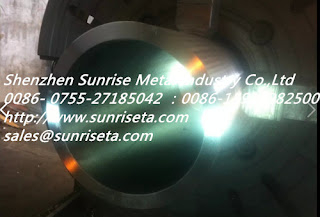The ratio of strength - weight of titanium ranks the top place among the metal elements, and it has the characteristics of a high melting point, small specific gravity, toughness, fatigue resistance, corrosion resistance, low thermal conductivity, good resistance performance towards high and low temperature, small stress in thermal shock conditions.
The hardness of titanium is nearly equal to that of steel, but it weighs almost only half of the same volume of steel. Although titanium is slightly heavier than aluminum, its hardness is 2 times larger than aluminum. Now, a large number of titanium instead of steel is used in space rockets and missiles. With the decrease of manufacturing cost, the application areas of titanium become increasingly wide.
At room temperature, titanium can be safe to lay in a variety of acid and alkali solution, even aqua regia can not corrode it. Titanium is not afraid of sea water. A piece of titanium was once sink into the bottom of the sea, five years later, when it was taken up, it was pasted with many small animals and underwater plants on it, but it did not rust, and was still shiny.
Titanium can fuse with iron, aluminum, vanadium or molybdenum and other elements into alloy, creating high-strength light alloy, and it has been widely used in every respect, including aerospace (jet engines, missiles, and spacecraft), military, industrial process (chemical and petroleum products, desalination and paper), automotive, agri-food, medical (prostheses, orthopedic transplant and dental instruments and the filler), sporting goods, jewelry and cell phones.
The two most useful characteristics of titanium are corrosion resistance, and the highest ratio of strength- weight in metal. In the state of non-alloy, when compared the titanium strength with that of some steels, it is also lighter of 45%. It has two allotropic species, and five natural isotopes. From Ti to Ti, the highest abundance is Ti (73.8%). The chemical properties of titanium are similar to zirconium properties, because they share same number of valence electrons, and belong to the same family in the periodic table.
Basic Characteristics
Chemical symbol: Ti
Atomic number: 22
Atomic weight: 47.87
Density: 4.506 g/cm3
Melting point: 1688°C
Boiling point: 3287°C
Fusion heat: 14.15 kJ·mol−1
Heat of vaporization: 25 kJ·mol−1
Specific heat capacity: 25.060 J·mol−1·K−1
Heat conductivity: 21.9 W·m−1·K−1
Electrical resistivity: (20 °C) 0.420 µΩ·m
Modulus of elasticity: 106.4GMPa, 57% of stee
Atomic number: 22
Atomic weight: 47.87
Density: 4.506 g/cm3
Melting point: 1688°C
Boiling point: 3287°C
Fusion heat: 14.15 kJ·mol−1
Heat of vaporization: 25 kJ·mol−1
Specific heat capacity: 25.060 J·mol−1·K−1
Heat conductivity: 21.9 W·m−1·K−1
Electrical resistivity: (20 °C) 0.420 µΩ·m
Modulus of elasticity: 106.4GMPa, 57% of stee
Quality Assurance

Our study on refractory metals for decades enables us to fully understand their characteristics and features. We are your best choice as a provider for both pure titanium and titanium alloy products. From purchase of raw materials until the final production, we employ the most advanced testing equipment to ensure delivery of flawless and top quality products to you; our experienced technicians can also meet your demanding requirements on product details. 。

Application
Automotive industry, semiconductor industry, machinery manufacturing, aerospace, and metallurgical industry.















没有评论:
发表评论